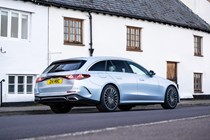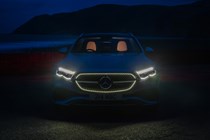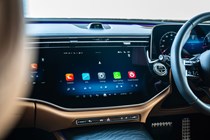
Mercedes-Benz E-Class Estate review
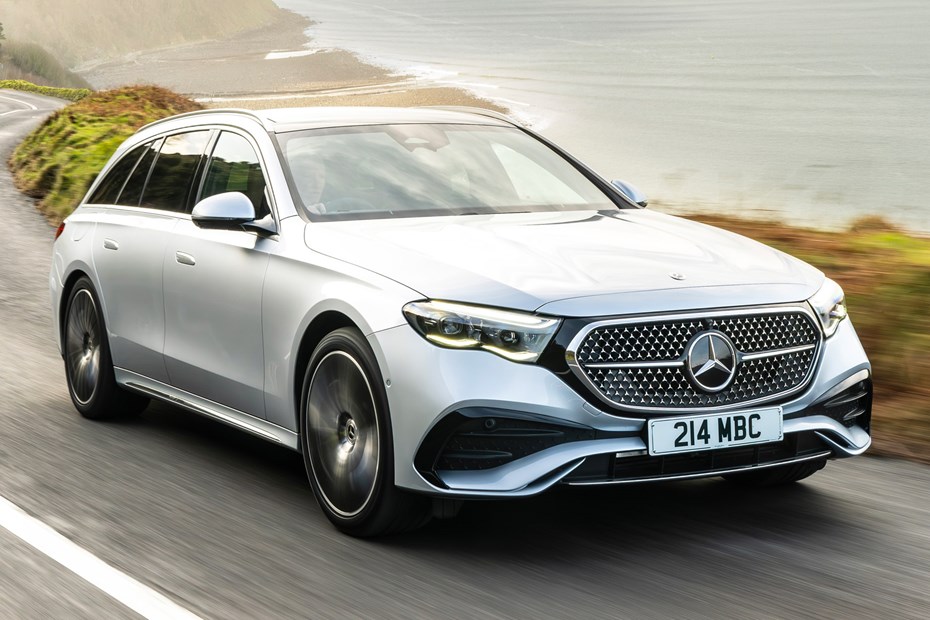
At a glance
| Price new | £58,470 - £91,160 |
|---|---|
| Used prices | £36,845 - £61,924 |
| Road tax cost | £620 |
| Insurance group | 41 - 50 |
Get an insurance quote with

|
|
| Fuel economy | 38.7 - 56.5 mpg |
| Miles per pound | 5.6 - 7.2 |
| Number of doors | 5 |
| View full specs for a specific version | |
Available fuel types
Petrol
Diesel
Hybrid
Pros & cons
- Good value for money
- Comfortable ride
- Spacious rear seats
- Expensive in top trims
- Sheer level of technology can prove daunting
- Boot not as large as previous model
Overview
The Mercedes Benz E-Class estate is the flagship wagon in the manufacturer’s lineup and has long been lauded as one of the best estate cars around. The E’s soft suspension, elegantly furnished interior and sturdy engines have earned the car the reputation as a bit of a mile muncher – the kind you’d be happy to load up with people and luggage before setting off for some distant beaches… or slopes… or both.
The latest generation of E-Class estate arrived in 2024, following the E-Class Saloon that went on sale in 2023. Bringing a more modern design courtesy of elements such as an illuminated grille surround and a sleeker rear end, Mercedes has packed the car full of technology. Back in late 2024, a halo six-cylinder diesel engine was introduced to the E-Class estate brochure – an expensive and ever more démodé power unit choice, but we reckon it’s one to savour while you still can.
Available with what the firm calls a ‘Superscreen,’ the latest E-Class gets a massive main touchscreen and a separate display for the front-seat passenger, with clever dimming meaning the driver can’t see it if YouTube is on, for example. This and the overall design make this feel more like Mercedes’ flagship S-Class than ever.
Showing Mercedes is keen to appeal to a younger audience, it features an in-built interior camera for taking selfies (yes, really) and even TikTok integration – although it’s worth noting both can only be used when the car is parked for safety reasons. A broad range of engines are also available, including petrol, diesel and a choice of plug-in hybrids.
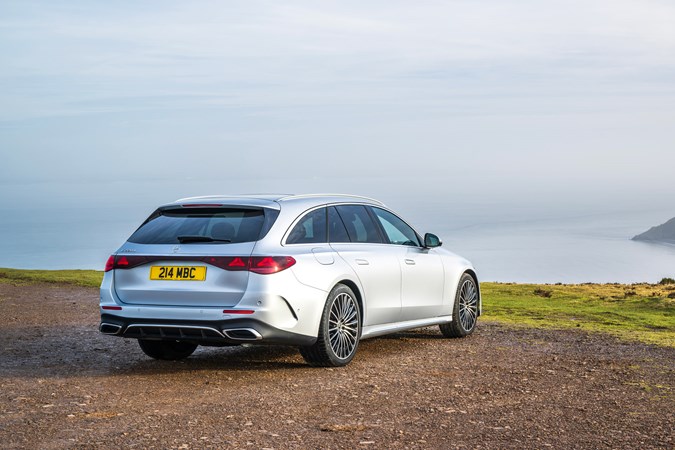
While Mercedes might have been pushing its electric ‘EQ’ models in recent years, it’s not forgotten about its core models like the E-Class. The large estate car segment looked as though it might’ve been in decline at one moment in time, but with the return of the Volvo V90, among perennial rivals like the BMW 5 Series Touring, the E-Class has still got its work cut out.
Prices for the E-Class Estate have also risen considerably, now starting from £57,780 or £66,860 for a plug-in hybrid. Standard equipment even on the AMG line trim is highly impressive, though, including keyless entry, heated front seats, park assist and a 14.0-inch touchscreen.
But is the Mercedes E-Class Estate worth considering? Read on for our full review, or click through to the verdict page if you’re short on time.
What’s it like inside?
If Mercedes wanted to make a statement with the latest E-Class Estate, it certainly succeeded. We’d argue it’s one of the most impressive interiors of any car on sale, at least from a visual point of view. Regardless of trim, you get a huge 14.4-inch touchscreen that dominates the interior.
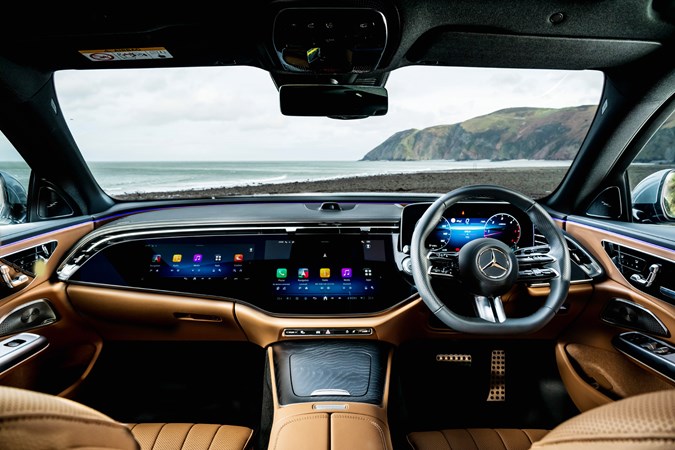
As is now commonplace, there are few physical buttons, though there are useful shortcut buttons for driver assistance features and a big ‘home’ button, but the screen itself is one of the least distracting to use, with big icons for core features and instant response to inputs. The ‘Hey Mercedes’ voice assistant is also excellent, responding to all the basic requests we asked it to – sounds simple, but many struggle. We’re not sure of the need for the Superscreen fitted to top-spec models, however.
Throughout the E-Class interior the quality is exceptional, and helps to make it feel like a premium product and justify its expensive price. The only slight complaint, which we say about every Mercedes, is that the touch-sensitive steering wheel buttons are fiddly and there are simply too many of them.
The Mercedes E-Class Estate’s spaciousness will no doubt be a key selling point. At more than five metres, it’s a particularly long car (though never feels it to drive) and that goes into giving it one of the most spacious interiors of any estate car, perhaps except the new Skoda Superb Estate.
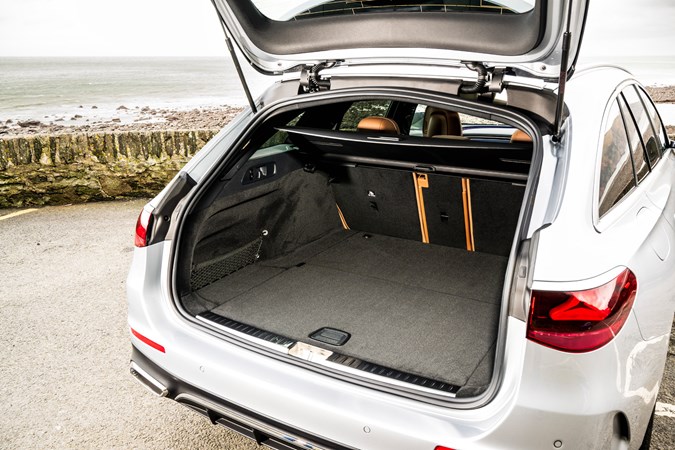
Even tall adults can sit comfortably behind taller adults in the front, while the boot at 615 litres is huge with a big flat floor that’s ideal for those with large dogs or a penchant for antique furniture shopping. Despite this, the boot is slightly smaller than the 640 litres provided with the previous model, and the plug-in hybrids have a considerably smaller trunk because of their large battery stored under the floor.
Comfort
If comfort is a top priority, you’ll struggle to beat the E-Class. All models come with big, soft seats – they’re quite flat, so aren’t the best for hard cornering, but that’s not what this Mercedes is about.
Electrical adjustment comes as standard, and the seats are also available with a massage function to help make journeys more comfortable. High-spec versions also debut a new feature for Mercedes that aims to alleviate car sickness from passengers who struggle with it. When the setting is activated, it automatically changes the seating position to one that helps with motion sickness, and automatic ‘bursts’ of air are released. It’s all highly clever stuff.
Safety
The 2024 Mercedes Benz E-Class saloon was tested by Euro NCAP and achieved five stars, with particularly high scores for adult and child occupants.
The level of standard safety kit is impressive, including blind-spot monitoring, adaptive cruise control and self-parking ability. A 360-degree parking camera is provided from the middle of the range, too. We found the E-Class’ safety assists to be some of the most impressive we’ve ever tested and shows Mercedes has spent lots of time developing them.
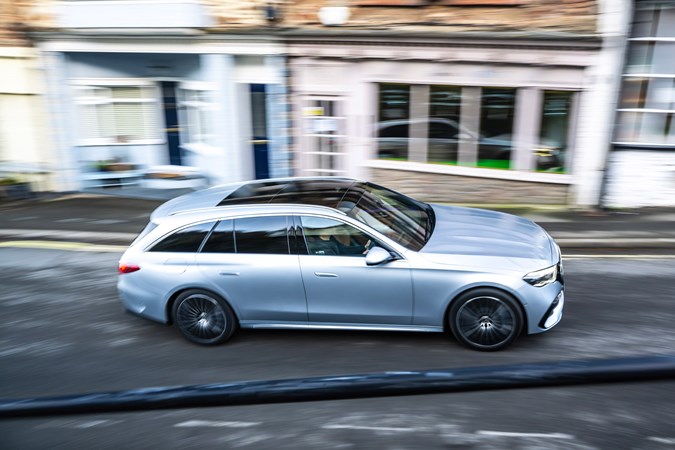
The lane assist is there to help you but is unobtrusive and quick shortcut buttons can disable it if you’re on a country lane, for example. Many manufacturers could learn lessons from Mercedes in this area.
Engines
Mercedes offers three conventional engines on its E-Class, one petrol and two diesels, which all come with a nine-speed automatic gearbox as standard and fuel-saving mild-hybrid technology.
We’ve tested a couple of the engines, including the E220d, which uses a 197hp 2.0-litre diesel engine. Though not the quickest – 0-62mph takes 7.9 seconds – it’s an ideal fit for this large estate car, as long as you’re not in a hurry. If you are, we recommend a look at the E450d, which uses a 367hp 3.0-litre diesel engine that reduces that 0-62mph time to 5.0 seconds, and comes with four-wheel-drive as standard too. It is considerably more expensive, however.
Currently, the only petrol model is the E200, which uses a 201hp 2.0-litre petrol engine that can feel a bit underpowered as it’s down on torque compared with the diesels. Based on our experience of an E-Class saloon with this engine, it can feel too small for a car of this size.
Plug-in hybrid
Mercedes makes some of the best plug-in hybrids and, on the E-Class, there’s the choice of the petrol E300e and diesel E300de. These each use the engines from the E200 and E220d as their base, but add in a 129hp electric motor that makes them noticeably more sprightly, and reduces the 0-62mph time to around 6.5 seconds on each.
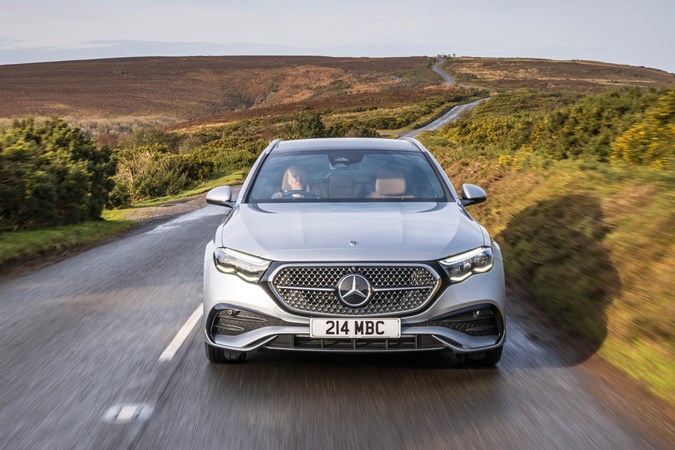
Both the plug-in hybrids also use a large (by PHEV standards) 25.7kWh battery, which Mercedes claims allows for up to an impressive 68 miles of range. It can also work with a DC rapid charger at speeds up to 55kW, which takes just 20 minutes to take it from 20 to 80 per cent.
What’s it like to drive?
When we tried the E-Class in saloon form, we were left underwhelmed and disappointed – it was neither as comfortable or refined as we expected. The Estate model, however, is a surprise improvement. The ride quality is considerably better, estate versions come as standard with an air-sprung rear axle designed to keep the car completely level even if the boot is heavily laden.
Whatever Mercedes has done, it’s worked. The E-Class Estate now rides exactly how a car of this type should, it’s comfortable and supple yet not overly soft. That’s even with our test car sitting on large 20-inch alloys. Refinement levels are top-drawer too, and it’s little wonder the car has become so popular with chauffeur fleets. Top-spec versions also benefit from an acoustic windscreen that helps keep noise down, and it’s wonderfully quiet on the move, with road and wind noise both kept to a minimum.
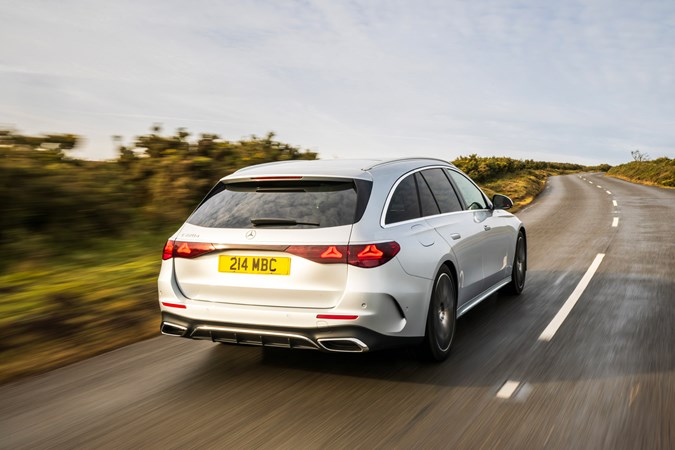
Like previous E-Class Estates, this new model isn’t exactly a hoot to drive. The steering can feel quite lifeless and doesn’t inspire confidence like the well-weighted setup of the BMW 5 Series Touring. While the E220d model is undoubtedly the pick of the E-Class range for any long-distance drivers, it’s not the most refined engine and can sound quite coarse.
If you really want to push on in your E-Class estate, then the six-cylinder 450 diesel is the engine. It’s a considerably more expensive option – the 450d starts from over £81k, which is a £22k premium over the starting price of the 220d – but it’s a power unit to savour. The torque is immediate and enduring, from the bottom of the rev range to the top the car pulls without respite. It’s a highly rewarding experience, but only if you’ve pockets deep enough and a willingness to put up with scowls of any climate activists with a pucker understanding of the E-Class engine range, rare as they may be.
One other thing to be wary of if you do pick the 450d engine is that it comes inseparably paired with the E’s optional airmatic air suspension. It’s a curious system, as the car wafts on its suspension but any sharp pot hole send shocks through. It isn’t especially pleasant, and certainly doesn’t lend the car to any great dynamism in the bends. Worth trying out first if you can before ticking the box
Ownership costs and maintenance
If you’re able to plug in a car regularly, one of the E-Class PHEVs makes the most sense. With a real-world 50-mile electric range, there’s lots of scope for most of your miles to be done on EV power, and if you can make the most of lower electricity rates or free workplace chargers (offered by many companies), it can make running them very affordable. That’s before we look into their attractive company car tax rates, too.
But if you do a lot of miles and longer trips, it’s hard to beat a diesel. The E220d, in particular, is an excellent choice. A large 66-litre fuel tank and around 60mpg on a steady longer run means you could get 1,000 miles with one fill – a sensational figure these days..
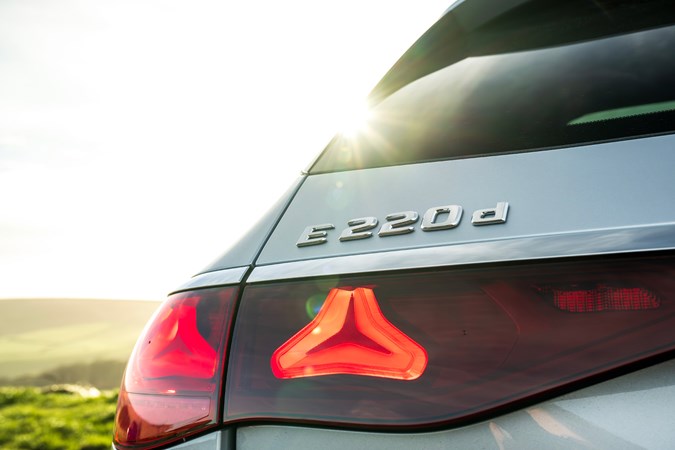
While Mercedes’ warranty only lasts three years, there is no mileage limit on it, unlike many other manufacturers. Again, with packages like that, it’s no wonder the firm’s cars are popular choices amongst fleet and chauffeur companies that will quickly rack up tens of thousands of miles.
What models and trims are available?
Mercedes offers two model lines as such on the E-Class Estate – sportier-styled AMG Line models being the most popular but it also sells more luxurious ‘Exclusive’ trims.
Standard kit is very generous, however, including heated and electric front seats, a large 14.4-inch touchscreen, 12.3-inch digital instrument cluster and keyless entry. AMG Line Premium trim brings a panoramic sunroof, digital key (allowing you to unlock it with a smartphone), 360-degree camera system and a Burmester sound system. Above this, AMG Line Premium Plus adds massaging seats, a heated steering wheel, a touchscreen for the passenger and a head-up display.
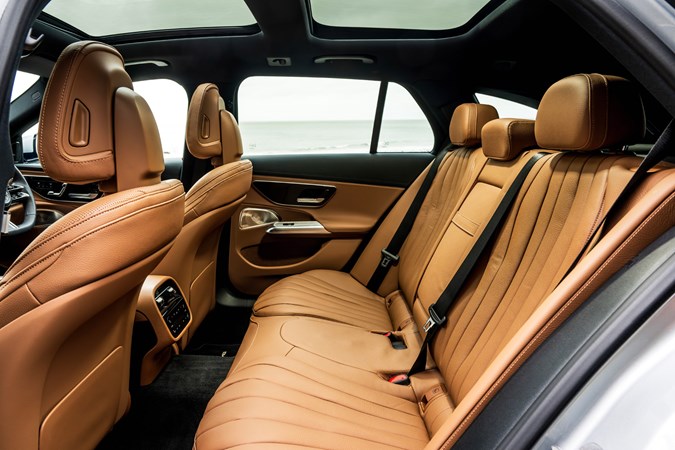
Exclusive Premium trim is roughly comparable with the AMG Line Premium and Exclusive Premium Plus with the top-spec AMG Line model, though it also comes with huge 21-inch alloys, open-pore wood trim and Nappa leather upholstery.




